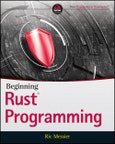Quickly learn the ropes with the Rust programming language using this practical, step-by-step guide
In Beginning Rust Programming, accomplished programmer and author Ric Messier delivers a highly practical, real-world guide to coding with Rust. Avoiding dry, theoretical content and “Hello, world”-type tutorials of questionable utility, the book dives immediately into functional Rust programming that takes advantage of the language’s blazing speed and memory efficiency.
Designed from the ground up to give you a running start to using the multiparadigm system programming language, this book will teach you to:
- Solve real-world computer science problems of practical importance
- Use Rust’s rich type system and ownership model to guarantee memory-safety and thread-safety
- Integrate Rust with other programming languages and use it for embedded devices
Perfect for programmers with some experience in other languages, like C or C++, Beginning Rust Programming is also a great pick for students new to programming and seeking a user-friendly and robust language with which to start their coding career.
Table of Contents
Introduction xix
Chapter 1: Game of Life: The Basics 1
Game of Life: The Program 2
Starting with Cargo 4
Putting the Pieces Together 5
Bringing In External Functionality 5
Namespaces 6
Generating the Game Grid 7
Dissecting Main 8
Defining Functions 8
Defining Variables 9
Datatypes 11
Arrays 12
Control Structures 14
Looking at More Function Functions 16
Returning Values 16
Passing Parameters 18
Scope 21
Compiling Programs 22
Summary 24
Exercises 25
Additional Resources 25
Chapter 2: Extended Life 27
Understanding Ownership 28
Extending Life 30
Adding Modules 32
Working with Command-Line Arguments 34
Option Types 36
Reading from Files 39
Extracting Values 41
Populating from the Vector 42
Outputting to the Terminal 43
Using Colors 44
Printing Generations 44
Summary 46
Exercises 48
Additional Resources 48
Chapter 3: Building A Library 49
References 50
First Pass 53
Traits and Implementations 56
Self-Identification 60
The Rest 60
Second Pass 62
The Driver 65
Summary 67
Exercises 69
Additional Resources 69
Chapter 4: Hangman 71
Our Data 74
The Traits 77
Implementations 79
Using the Option Enum 82
Finishing Up the Implementation 83
Reading Files and Selecting Words 84
Handling Errors Concisely 85
Generics and Bounds 87
A Vector of Lines 88
The Rest of the Story 90
Initialization 91
Playing the Game 92
Summary 94
Exercises 95
Additional Resources 95
Chapter 5: In Concurrence 97
The Dining Philosophers 98
Mutexes and Semaphores 101
Interprocess Communications 103
The Main Event 106
Unix Sockets 107
File and Directory Handling 109
Closures 112
Threading in the Main 114
Creating Streams 115
Cryptographic Hashing 116
Creating Threads 117
Summary 118
Exercises 119
Additional Resources 119
Chapter 6: Clients and Servers 121
Planning 123
Network Programming 125
Programming Sockets 128
Rust TCP Server 131
Handling Requests 134
Operating System Calls 137
Summary 139
Exercises 140
Additional Resources 140
Chapter 7: Client-Side Applications 141
Encryption 142
Encryption Algorithms 144
Going Hybrid 145
Encryption Algorithms 147
Transport Layer Security (TLS) 147
TLS Server 151
Remote Access Client 154
Creating the Connection 156
Validating Input 157
Regular Expressions 157
The Final Function 159
Summary 163
Exercises 164
Additional Resources 164
Chapter 8: Going Relational 165
Application Architectures 166
n-Tier Applications 167
Microservices 169
Model-View-Controller 171
Databases 172
Structured Query Language 172
Server or Embedded 175
Accessing Databases 176
Writing a Database Program 177
Main and Modules 178
Database Functions 183
Adding Records 184
Listing Records 186
Summary 189
Exercises 190
Additional Resources 190
Chapter 9: NO(SQL) Going 191
Assertions 192
Design by Contract 195
NoSQL 198
Working with MongoDB 202
Inserting Data 202
Reading in Data from a File 206
Populating the Database 207
Retrieving Values 209
Summary 213
Exercises 214
Additional Resources 214
Chapter 10: Web Communications 215
Style Guides 216
Hypertext Transfer Protocol 219
Programmatic Communication 222
Web Communication Over TLS 227
Client Communication 229
Jumping Ahead 232
Jumping Back 237
Summary 238
Exercises 239
Additional Resources 240
Chapter 11: Web Server 241
Offensive vs. Defensive Programming 242
Web Application Communications 245
Web Application Parameters 245
Asynchronous JavaScript and XML 248
Representational State Transfer 249
APIs in Node.js and Python 250
API Server in Rust 252
Rust Rocket 255
Summary 262
Exercises 262
Additional Resources 263
Chapter 12: Getting to the System 265
Extending Functionality 266
Windows Registry 272
Programmatic Access to the Registry 275
Using Rust to Access the Registry 277
System Information with Rust 282
Persistence (for Fun) 287
Summary 289
Exercises 290
Additional Resources 290
Chapter 13: Device Programming 291
Logging 292
Using syslog 292
Using Windows Event Logs 299
Working with Raspberry Pi 305
Lighting Lights 310
Reading GPIO 315
Summary 318
Exercises 319
Additional Resources 319
Chapter 14: Collecting Stuff 321
Arrays and Vectors 322
Linked Lists 329
Stacks 333
Queues 336
Sorting 337
Search Trees 340
Summary 345
Exercises 346
Additional Resources 346
Chapter 15: Odds and Sods 347
Unit Testing 348
Testing Types 350
Test Plans 351
Unit Tests 353
Recursion 360
Machine Learning 364
Chatbots 366
Neural Networks 369
Summary 371
Exercises 373
Additional Resources 373
Index 375








